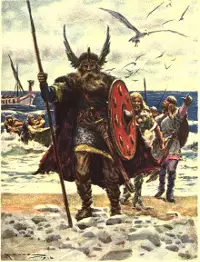Leif Erikson (also known as "Ericson") is generally regarded as the first European to have set foot in North America.
Erikson's grandfather Thorvald had to leave Norway because of a violent resolution to a quarrel; he went to Iceland. His son, known as Erik the Red, had his own difficulties in the same vein and left Iceland, becoming the first known Viking to set foot on the island of Greenland, in 980. He called it that as a bit of a marketing ploy: He wanted to convince his countrymen to join him in his new home.

A few hundred people did join Erik the Red in Greenland, and this is where Leif, Erik's son, grew up. He is thought to have been born in 970, in Iceland. About 1000, he sailed to Norway to pledge his loyalties to Norway's King Olaf I Tryggvason. He sailed back west and ended up in North America. Whether he went there intentionally is an open question. The two historical accounts of the exploits of "Leif the Lucky," as he was also known, differ on this point. One account says that he got blown off course and arrived in North America by accident; another account says that he went there after hearing of the land mass from another sailor.

What is generally thought to be the case by many historians is that Leif Erikson made landfall in what is now Newfoundland about the year 1000. He and his crew stayed there for a time, naming the area Vinland (after the vines growing there) and setting up a base camp. Then, they returned to Greenland.
Erikson did not make another voyage to the New World. His son, Thorkel Leifsson, is known to have become leader of the Greenland settlement in 1025, so his father is thought to have died about that time. Leif's brothers Thorvald and Thorstein are known to have visited Vinland.
Archaeologists in the 19th Century discovered remains of the Vinland settlement at L'Anse aux Meadows.